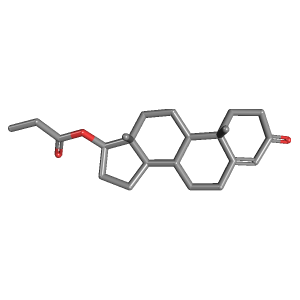Testosterone Propionate Information
Click here to view all Testosterone Propionate productsThe information, including but not limited to, text, graphics, images and other material contained on this website are for informational purposes only. No material on this site is intended to be a substitute for the consultation, diagnosis, and/or medical treatment of a qualified physician or healthcare provider.


Testosterone propionate is a synthetic form of testosterone, which is an endogenous hormone produced in the human body. It belongs to the class of androgenic-anabolic steroids (AAS) and is commonly used for various medical and non-medical purposes. Here are some details about testosterone propionate:
- Medical Uses: Testosterone propionate has been used in medical settings to treat conditions caused by low levels of testosterone in males, such as hypogonadism (a condition where the testes do not produce enough testosterone). It may also be prescribed for delayed puberty in adolescent males and certain types of breast cancer in women.
- Performance Enhancement: Testosterone propionate is popular among athletes and bodybuilders for its anabolic effects. It can enhance muscle growth, strength, and athletic performance when used in combination with proper diet and exercise. However, it is important to note that the non-medical use of testosterone propionate is generally considered illegal and unethical in competitive sports.
- Administration: Testosterone propionate is administered via intramuscular injection. It is available in the form of an oily solution that is typically injected into the buttock muscle. The frequency of administration may vary depending on the purpose of use, but it is commonly injected every other day or every third day to maintain stable blood levels.
- Esters and Half-Life: Testosterone propionate is an esterified form of testosterone, which means it is chemically modified to have an ester group attached to it. This modification affects the rate at which the testosterone is released into the bloodstream. Testosterone propionate has a relatively short half-life of approximately 2-3 days, which requires more frequent injections compared to other testosterone esters.
- Side Effects: Like other androgenic-anabolic steroids, testosterone propionate can cause several side effects. These may include acne, oily skin, hair loss, increased body hair growth, mood changes, aggression, liver toxicity, cardiovascular issues, suppression of natural testosterone production, and hormonal imbalances. The severity and likelihood of these side effects may vary depending on individual factors, dosage, and duration of use.
- Legal Status: The use of testosterone propionate without a valid medical prescription is generally illegal in many countries. It is classified as a controlled substance due to its potential for abuse and misuse. The laws and regulations regarding testosterone propionate and other AAS may differ from one country to another, so it's important to consult the local laws and guidelines if considering its use.
It's worth noting that the use of testosterone propionate or any other AAS should always be approached with caution. If you have any specific concerns or considerations regarding testosterone propionate, it is advisable to consult a healthcare professional or a qualified medical practitioner who can provide personalized advice and guidance.
How Testosterone Propionate works?
Testosterone propionate works by mimicking the effects of endogenous testosterone in the body. Once administered, it undergoes a series of processes that lead to its conversion into active testosterone. Here's how testosterone propionate works:
- Administration: Testosterone propionate is typically administered via intramuscular injection. Once injected, it forms a depot in the muscle tissue.
- Absorption and Release: Testosterone propionate is slowly released from the injection site into the bloodstream. The ester attached to the testosterone molecule slows down its release, resulting in a sustained and controlled release of testosterone over time.
- Binding to Androgen Receptors: In the bloodstream, testosterone binds to androgen receptors found in various tissues, including muscle cells. The binding of testosterone to these receptors triggers a cascade of cellular events.
- Activation of Androgen Receptor Signaling: Testosterone activates the androgen receptors, which are present in the nucleus of the cells. This activation leads to changes in gene expression, influencing protein synthesis, cell growth, and various physiological processes.
- Anabolic Effects: Testosterone, including testosterone propionate, exerts anabolic effects on muscle tissue. It enhances protein synthesis, which promotes muscle growth, repair, and recovery. This can result in increased muscle mass, strength, and physical performance.
- Androgenic Effects: Testosterone propionate also has androgenic effects, which are responsible for the development and maintenance of male sexual characteristics. These effects include deepening of the voice, growth of facial and body hair, and stimulation of the prostate gland.
- Feedback Mechanism: When exogenous testosterone, such as testosterone propionate, is introduced into the body, it can suppress the production of endogenous testosterone by the testes through a negative feedback mechanism. This suppression occurs because the body senses sufficient levels of testosterone and signals the testes to reduce their natural production.
It's important to note that the effects of testosterone propionate can vary depending on factors such as dosage, duration of use, individual response, and other accompanying factors like diet and exercise. Additionally, the effects of testosterone propionate are not limited to muscle tissue and can impact other systems in the body, including the cardiovascular, hematological, and endocrine systems.
As with any medication, it is crucial to use testosterone propionate under the guidance of a healthcare professional and in accordance with prescribed dosages to minimize the risks and optimize the potential benefits.
Synonyms of Testosterone Propionate
- testosterone propionate
- 57-85-2
- Agovirin
- Androlon
- Androteston
- Aquaviron
- Hormoteston
- Enarmon
- Bio-testiculina
- Androtest P
- Androsteston
- Sterandryl
- Testonique
- Andronate
- Masenate
- Orchiol
- Orchistin
- Pantestin
- Propiokan
- Solvotest
- Synandrol
- Synerone
- Telipex
- Testaform
- Testodet
- Testodrin
- Testogen
- Testolets
- Testormol
- Testosid
- Testoxyl
- Testrex
- Tostrin
- Uniteston
- Nasdol
- Vulvan
- Neo-Hombreol
- Okasa-Mascul
- Andrusol-P
- Oreton propionate
- Orchisterone
- Androgen
- Testosteroni propionas
- NSC 9166
- Testosteron propionate
- Testosterone (propionate)
- Homandren (amps)
- CCRIS 575
- Testoviron (ampule)
- Testosterone-17beta propionate
- Testosterone-17beta-propionate
- Testosterone-17-beta-propionate
- Testosterone, propionate
- NSC-9166
- EINECS 200-351-1
- Testosteron 17-propionate
- Testosterone-17-propionate
- Testosterone propionate ciii
- CHEMBL1170
- 17beta-(Propionyloxy)androst-4-en-3-one
- UNII-WI93Z9138A
- AI3-26378
- CHEBI:9466
- 17beta-Hydroxyandrost-4-en-3-one propionate
- DTXSID9036515
- Testosterone 17.beta.-propionate
- Testosterone-17.beta.-propionate
- 17beta-Hydroxy-4-androsten-3-one 17-propionate
- WI93Z9138A
- Testosterone propionate [USP:JAN]
- Androst-4-en-3-one, 17beta-hydroxy-, propionate
- delta(sup 4)-Androstene-17-beta-propionate-3-one
- Testosterone propionate [USAN:JAN]
- 17beta-Hydroxyandrost-4-en-3-one-17beta-propionate
- NRB-03689
- Androst-4-en-3-one, 17-(1-oxopropoxy)-, (17b)-
- [(8R,9S,10R,13S,14S,17S)-10,13-dimethyl-3-oxo-1,2,6,7,8,9,11,12,14,15,16,17-dodecahydrocyclopenta[a]phenanthren-17-yl] propanoate
- Androst-4-en-3-one, 17-(1-oxopropoxy)-, (17beta)-
- Androst-4-en-3-one, 17-(1-oxopropoxy)-, (17.beta.)-
- NCGC00016254-01
- (17beta)-3-oxoandrost-4-en-17-yl propanoate
- (17beta)-3-oxoandrost-4-en-17-yl propionate
- 17-propionyl-17beta-hydroxyandrost-4-en-3-one
- DTXCID7016515
- CAS-57-85-2
- testosteron-17-propionat
- Prestwick_432
- testosteronpropionat-
- Testex (TN)
- 17.beta.-(Propionyloxy)androst-4-en-3-one
- .DELTA.4-androstene-17.beta.-propionate-3-one
- 17.beta.-hydroxyandrost-4-en-3-one, propionate
- 3-Oxoandrost-4-en-17-yl propionate, (17.beta.)-
- Prestwick0_000401
- Prestwick1_000401
- Prestwick2_000401
- Prestwick3_000401
- Androst-4-en-3-one, 17.beta.-hydroxy-, propionate
- 17-(1-Oxopropoxy)androst-4-en-3-one, (17.beta.)-
- SCHEMBL4044
- BSPBio_000322
- MLS002153796
- Testosterone propionate, solid
- SPBio_002261
- BPBio1_000356
- GTPL7100
- Testosterone-17.beta.propionate
- NSC9166
- HMS1569A04
- HMS2096A04
- HMS2272K06
- HMS3713A04
- Testosterone propionate (Agovirin)
- HY-B1269
- TESTOSTERONE PROPIONATE [MI]
- Tox21_110330
- Tox21_302270
- BBL029912
- BDBM50215709
- LMST02020076
- MFCD00003653
- STK801834
- Testosterone propionate (JP17/USP)
- TESTOSTERONE PROPIONATE [JAN]
- AKOS005622513
- AKOS015842719
- Tox21_110330_1
- CCG-220401
- CS-4905
- CS-O-30780
- DB01420
- TESTOSTERONE PROPIONATE [MART.]
- TESTOSTERONE PROPIONATE [VANDF]
- TESTOSTERONE PROPIONATE [WHO-DD]
- TESTOSTERONE PROPIONATE [WHO-IP]
- NCGC00179602-01
- NCGC00179602-03
- NCGC00179602-06
- NCGC00255481-01
- AC-12172
- AC-33160
- SMR000058348
- VS-09499
- BCP0726000215
- LS-148823
- TESTOSTERONE PROPIONATE [GREEN BOOK]
- T0028
- TESTOSTERONE PROPIONATE [ORANGE BOOK]
- TESTOSTERONI PROPIONAS [WHO-IP LATIN]
- TESTOSTERONE PROPIONATE [EP MONOGRAPH]
- TESTOSTERONE PROPIONATE [USP IMPURITY]
- C08158
- D00959
- TESTOSTERONE PROPIONATE [USP MONOGRAPH]
- Testosterone Propionate 1.0 mg/ml in Acetonitrile
- Testosterone propionate, tested according to Ph.Eur.
- W-105436
- BRD-K90553655-001-03-6
- Q10354588
- WLN: L E5 B666 OV MUTJ A E FO52 -B&AEF
- Androst-4-en-3-one, 17-(1-oxopropoxy)-(17.beta.)-
- Androst-4-en-3-uno, 17-(1) oxopropoxi-, (17beta)-
- Testosterone propionate, British Pharmacopoeia (BP) Reference Standard
- Testosterone propionate, European Pharmacopoeia (EP) Reference Standard
- Testosterone propionate, United States Pharmacopeia (USP) Reference Standard
- (1S,3aS,3bR,9aR,9bS,11aS)-9a,11a-dimethyl-7-oxo-1H,2H,3H,3aH,3bH,4H,5H,7H,8H,9H,9aH,9bH,10H,11H,11aH-cyclopenta[a]phenanthren-1-yl propanoate
- Propionic acid (8R,9S,10R,13S,14S,17S)-10,13-dimethyl-3-oxo-2,3,6,7,8,9,10,11,12,13,14,15,16,17-tetradecahydro-1H-cyclopenta[a]phenanthren-17-yl ester
- Propionic acid 10,13-dimethyl-3-oxo-2,3,6,7,8,9,10,11,12,13,14,15,16,17-tetradecahydro-1H-cyclopenta[a]phenanthren-17-yl ester
- Propionic acid 10,13-dimethyl-3-oxo-2,3,6,7,8,9,10,11,12,13,14,15,16,17-tetradecahydro-1H-cyclopenta[a]phenanthren-17-yl ester(Testosterone Propionate)
- Testosterone propionate for system suitability, European Pharmacopoeia (EP) Reference Standard

